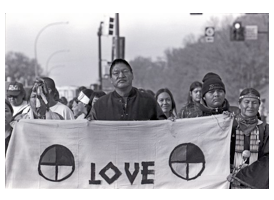GUEST WORDS-High above, somewhere behind the black glass façade, President-elect Donald J. Trump was huddled with his inner circle, plotting just how they would “drain the swamp” and remake Washington, perhaps the world. On the street far below, inside a warren of metal fencing surrounded by hefty concrete barriers with “NYPD” emblazoned on them, two middle-aged women were engaged in a signage skirmish. One held aloft a battered poster that read “Love Trumps Hate”; just a few feet away, the other brandished a smaller slice of cardboard that said “Get Over It.” (Photo above: Security agents in front of Trump Tower, New York.)
I was somewhere in between ... and the Secret Service seemed a little unnerved.
Trump Tower is many things -- the crown jewel skyscraper in Donald Trump’s real-estate empire, the site of the Trump Organization’s corporate offices, a long-time setting for his reality television show, The Apprentice, and now, as the New York Times describes it, “a 58-story White House in Midtown Manhattan.” It is also, as noted above its front entrance: “OPEN TO THE PUBLIC 8 AM to 10 PM.”
When planning for the tower began in the late 1970s, Trump -- like other developers of the era -- struck a deal with the city of New York. In order to add extra floors to the building, he agreed to provide amenities for the public, including access to restrooms, an atrium, and two upper-level gardens.
When I arrived at Trump Tower, less than a week after Election Day, the fourth floor garden was roped off, so I proceeded up the glass escalator, made a right, and headed through a door into an outdoor pocket park on the fifth floor terrace. Just as I entered, a group of Japanese tourists was leaving and, suddenly, I was alone, a solitary figure in a secluded urban oasis.
But not for long.
Taking a seat on a silver aluminum chair at a matching table, I listened closely. It had been a zoo down on Fifth Avenue just minutes before: demonstrators chanting “love trumps hate,” Trump supporters shouting back, traffic noise echoing in the urban canyon, the “whooooop” of police sirens, and a bikini-clad woman in body paint singing in front of the main entrance. And yet in this rectangular roof garden, so near to America’s new White House-in-waiting, all was placid and peaceful. There was no hint of the tourist-powered tumult below or of the potentially world-altering political machinations above, just the unrelenting white noise-hum of the HVAC system.
On His Majesty’s Secret Service
The Stars and Stripes flies above the actual White House in Washington, D.C. Inside the Oval Office, it’s joined by another flag -- the seal of the president of the United States emblazoned on a dark blue field. Here, however, Old Glory flies side by side with slightly tattered black-and-silver Nike swoosh flags waving lazily above the tony storefronts -- Louis Vuitton and Saint Laurent, Burberry and Chanel -- of Manhattan’s 57th Street, and, of course, Trump Tower-tenant Niketown.
That I was standing beneath those flags gazing down at luxe retailers evidently proved too much to bear for those who had been not-so-subtly surveilling me. Soon a fit, heavily armed man clad in black tactical gear -- what looked to my eye like a Kevlar assault suit and ballistic vest -- joined me in the garden. “How’s it going?” I asked, but he only nodded, muttered something incomprehensible, and proceeded to eyeball me hard for several minutes as I sat down at a table and scrawled away in my black Moleskine notepad.
My new paramilitary pal fit in perfectly with the armed-camp aesthetic that’s blossomed around Trump Tower. The addition of fences and concrete barriers to already clogged holiday season sidewalks has brought all the joys of the airport security line to Fifth Avenue. The scores of police officers now stationed around the skyscraper give it the air of a military outpost in a hostile land. (All at a bargain basement price of $1 million-plus per day for the city of New York.) Police Commissioner James O’Neill recently reeled off the forces which -- in addition to traffic cops, beat cops, and bomb-sniffing dogs -- now occupy this posh portion of the city: “specialized units, the critical response command, and the strategic response group, as well as plainclothes officers and counter-surveillance teams working hand-in-hand with our intelligence bureau and our partners in the federal government, specifically the Secret Service.” The armed man in tactical gear who had joined me belonged to the latter agency.
“You one of the reporters from downstairs?” he finally asked.
“Yeah, I’m a reporter,” I replied and then filled the silence that followed by saying, “This has got to be a new one, huh, having a second White House to contend with?”
“Yeah, pretty much,” he answered, and then assured me that most visitors seemed disappointed by this park. “I think everyone comes up thinking there’ll be a little more, but it’s like ‘yeah, okay.’”
Small talk, however, wasn't the agent’s forte, nor did he seem particularly skilled at intimidation, though it was clear enough that he wasn’t thrilled to have this member of the public in this public space. Luckily for me (and the lost art of conversation), we were soon joined by “Joe.” An aging bald man of not insignificant girth, Joe appeared to have made it onto the Secret Service’s managerial track. He didn’t do commando-chic. He wasn’t decked out in ridiculous SWAT-style regalia, nor did he have myriad accessories affixed to his clothing or a submachine gun strapped to his body. He wore a nondescript blue suit with a silver and blue pin on his left lapel.
I introduced myself as he took a seat across from me and, in response, though working for a federal agency, he promptly began a very NYPD-style interrogation with a very NYPD-style accent.
“What’s going on, Nick?” he inquired.
“Not too much.”
“What are you doing? You’re all by yourself here…”
“Yeah, I’m all by my lonesome.”
“Kinda strange,” he replied in a voice vaguely reminiscent of Robert De Niro eating a salami sandwich.
“How so?”
“I don’t know. What are you doing? Taking notes?” he asked.
I had reflexively flipped my notepad to a fresh page as I laid it between us on the table and Joe was doing his best to get a glimpse of what I’d written.
I explained that I was a reporter. Joe wanted to know for whom I worked, so I reeled off a list of outlets where I’d been published. He followed up by asking where I was from. I told him and asked him the same. Joe said he was from Queens.
“What do you do for a living?” I asked.
“Secret Service.”
“I was just saying to your friend here that it must be a real experience having a second White House to contend with.”
“Yeah, you could call it that,” he replied, sounding vaguely annoyed. Joe brushed aside my further attempts at small talk in favor of his own ideas about where our conversation should go.
“You got some ID on you?” he asked.
“I do,” I replied, offering nothing more than a long silence.
“Can I see it?”
“Do you need to?”
“If you don’t mind,” he said politely. Since I didn’t, I handed him my driver’s license and a business card. Looking at the former, with a photo of a younger man with a much thicker head of hair, Joe asked his most important question yet: “What did you do to your hair?”
“Ah yes,” I replied with a sigh, rubbing my hand over my thinned-out locks. “It’s actually what my hair did to me.”
He gestured to his own follically challenged head and said, “I remember those days.”
Trump Tower’s Public Private Parts
Joe asked if there was anything he could do for me, so I wasn’t bashful. I told him that I wanted to know what his job was like -- what it takes to protect President-elect Donald Trump and his soon-to-be second White House. “You do different things. Long hours. Nothing out of the ordinary. Probably the same as you,” he said. I told him I really doubted that and kept up my reverse interrogation. “Other than talking to me, what did you do today?” I asked.
“I dunno,” he responded. “Look around. Security. We’re Secret Service.” It was, he assured me, a boring job.
“Come on,” I said. “There’s got to be a lot of challenges to securing a place like this. You’ve got open public spaces just like this one.”
There are, in fact, more than 500 privately owned public spaces, or POPS, similar to this landscaped terrace, all over the city. By adding the gardens, atrium, and other amenities way back when, Trump was able to add about 20 extra floors to this building, a deal worth at least $500 million today, according to the New York Times. And in the post-election era, Trump Tower now boasts a new, one-of-a-kind amenity. The skies above it have been declared “national defense airspace” by the Federal Aviation Administration. “The United States government may use deadly force against the airborne aircraft, if it is determined that the aircraft poses an imminent security threat,” the agency warned in a recent notice to pilots.
Back on the fifth floor, a metal plaque mounted on an exterior wall lays out the stipulations of the POPs agreement, namely that this “public garden” is to have nine large trees, four small trees, 148 seats, including 84 moveable chairs, and 21 tables. None of the trees looked particularly large. By my count the terrace was also missing three tables -- a type available online starting at $42.99 -- and about 20 chairs, though some were stacked out of view and, of course, just two were needed at the moment since Mr. Tactical Gear remained standing, a short distance away, the whole time.
This tiny secluded park seemed a world away from the circus below, the snarl of barricades outside the building, the tourists taking selfies with the big brassy “Trump Tower” sign in the background, and the heavily armed counterterror cops standing guard near the revolving door entrance.
I remarked on this massive NYPD presence on the streets. “It’s their city,” Joe replied and quickly changed topics, asking, “So business is good?”
“No, business is not too good. I should have picked a different profession,” I responded and asked if the Secret Service was hiring. Joe told me they were and explained what they looked for in an agent: a clean record, college degree, “law experience.” It made me reflect upon the not-so-clean record of that agency in the Obama years, a period during which its agents were repeatedly cited for gaffes, as when a fence-jumper made it all the way to the East Room of the White House, and outrageous behavior, including a prostitution scandal involving agents preparing the way for a presidential visit to Colombia.
“What did you do before the Secret Service?” I inquired. Joe told me that he’d been a cop. At that point, he gave his black-clad compatriot the high sign and the younger man left the garden.
“See, I’m no threat,” I assured him. Joe nodded and said he now understood the allure of the tiny park. Sensing that he was eager to end the interrogation I had turned on its head, I began peppering him with another round of questions.
 Instead of answering, he said, “Yeah, so anyway, Nick, I’ll leave you here,” and then offered me a piece of parting advice -- perhaps one that no Secret Service agent protecting a past president-elect has ever had occasion to utter, perhaps one that suggests he’s on the same wavelength as the incoming commander-in-chief, a man with a penchant for ogling women (to say nothing of bragging about sexually assaulting them). “You should come downstairs,” Joe advised, his eyes widening, a large grin spreading across his face as his voice grew animated for the first time. “There was a lady in a bikini with a painted body!”
Instead of answering, he said, “Yeah, so anyway, Nick, I’ll leave you here,” and then offered me a piece of parting advice -- perhaps one that no Secret Service agent protecting a past president-elect has ever had occasion to utter, perhaps one that suggests he’s on the same wavelength as the incoming commander-in-chief, a man with a penchant for ogling women (to say nothing of bragging about sexually assaulting them). “You should come downstairs,” Joe advised, his eyes widening, a large grin spreading across his face as his voice grew animated for the first time. “There was a lady in a bikini with a painted body!”
Joe walked off and, just like that, I was alone again, listening to the dull hum of the HVAC, seated in the dying light of the late afternoon. A short time later, on my way out of the park, I passed the Secret Service agent in tactical gear. “I think you’re the one that found the most entertainment out here all day,” he said, clearly trying to make sense of why anyone would spend his time sitting in an empty park, scribbling in a notebook. I mentioned something about sketching out the scene, but more than that, I was attempting to soak in the atmosphere, capture a feeling, grapple with the uncertain future taking shape on the chaotic avenue below and high above our heads in Manhattan’s very own gilt White House. I was seeking a preview, you might say, of Donald Trump’s America.
Descending the switchback escalators, I found myself gazing at the lobby where a scrum of reporters stood waiting for golden elevator doors to open, potentially disgorging a Trump family member or some other person hoping to serve at the pleasure of the next president. Behind me water cascaded several stories down a pink marble wall, an overblown monument to a bygone age of excess. Ahead of me, glass cases filled with Trump/Pence 2016 T-shirts, colognes with the monikers “Empire” and “Success,” the iconic red “Make America Great Again” one-size-fits-all baseball cap, stuffed animals, and other tchotchkes stood next to an overflowing gilded garbage can. Heading for the door, I thought about all of this and Joe and his commando-chic colleague and Trump’s deserted private-public park, and the army of cops, the metal barricades, and the circus that awaited me on the street. I felt I’d truly been given some hint of the future, a whisper of what awaits. I also felt certain I’d be returning to Trump Tower -- and soon.
(Nick Turse is the managing editor of TomDispatch, … where this piece was first posted … a fellow at the Nation Institute, and a contributing writer for the Intercept. His book Tomorrow's Battlefield: U.S. Proxy Wars and Secret Ops in Africa recently received an American Book Award. His latest book is Next Time They’ll Come to Count the Dead: War and Survival in South Sudan. His website is NickTurse.com.)
-cw
 John Steinbeck’s late son Thom, an accomplished writer, was furious about Judge Cochran’s opinion after it was rendered. In a 2012 interview with the Beaumont (Texas) Enterprise, Thom’s wife Gail Steinbeck, an attorney, said that “his ears turned red” when her husband first learned of Ex Parte Briseno, in his view a gross distortion of his father’s meaning. In a statement published by The New York Times on August 8, 2012, Thom complained bitterly about the misconstruction of his father's intentions in writing Of Mice and Men:
John Steinbeck’s late son Thom, an accomplished writer, was furious about Judge Cochran’s opinion after it was rendered. In a 2012 interview with the Beaumont (Texas) Enterprise, Thom’s wife Gail Steinbeck, an attorney, said that “his ears turned red” when her husband first learned of Ex Parte Briseno, in his view a gross distortion of his father’s meaning. In a statement published by The New York Times on August 8, 2012, Thom complained bitterly about the misconstruction of his father's intentions in writing Of Mice and Men: 






 What both Route 66 and the Phil Silvers Show have in common, compared to modern shows, is that the old television system was of inherently low definition. It was a fuzzy picture at best. For this reason, it could not show human expression as well as film. Let's try to explain this a little more precisely. Even in old films, it was possible to convey emotions such as suspicion or guilt with a glance or a subtle change of expression -- possibly a nod or a shifting of the eyes. Even the earliest 35 mm film was fully capable of showing these things. Early television wasn't. So instead of an actor warning his buddy that the robbers are in the next room by using a shift of the head, the old television action hero would have to convey the same idea with a shout and a lot of words: "Look out! They're behind the door!"
What both Route 66 and the Phil Silvers Show have in common, compared to modern shows, is that the old television system was of inherently low definition. It was a fuzzy picture at best. For this reason, it could not show human expression as well as film. Let's try to explain this a little more precisely. Even in old films, it was possible to convey emotions such as suspicion or guilt with a glance or a subtle change of expression -- possibly a nod or a shifting of the eyes. Even the earliest 35 mm film was fully capable of showing these things. Early television wasn't. So instead of an actor warning his buddy that the robbers are in the next room by using a shift of the head, the old television action hero would have to convey the same idea with a shout and a lot of words: "Look out! They're behind the door!" 




 “Many of us, me particularly, are from the units that have hurt you over the many years. We came. We fought you. We took your land. We signed treaties that we broke. We stole minerals from your sacred hills. We blasted the faces of our presidents onto your sacred mountain. When we took still more land and then we took your children and then we tried to make your language and we tried to eliminate your language that God gave you, and the Creator gave you.
“Many of us, me particularly, are from the units that have hurt you over the many years. We came. We fought you. We took your land. We signed treaties that we broke. We stole minerals from your sacred hills. We blasted the faces of our presidents onto your sacred mountain. When we took still more land and then we took your children and then we tried to make your language and we tried to eliminate your language that God gave you, and the Creator gave you.



 That sounds harsh. But, lest we forget, Republicans paid virtually no political price for their eight years of anti-Obama obstruction. Voters didn’t seem to care that Republicans thwarted a president who twice won elections with a majority of the popular vote. Why would they punish Democrats for standing in steadfast opposition to an unqualified poseur who was rejected last month by 53.8 percent of all voters? Chuck Schumer, the new Senate minority leader, is indeed warning that when Trump gets too extreme, “we’ll go after him with everything we’ve got.”
That sounds harsh. But, lest we forget, Republicans paid virtually no political price for their eight years of anti-Obama obstruction. Voters didn’t seem to care that Republicans thwarted a president who twice won elections with a majority of the popular vote. Why would they punish Democrats for standing in steadfast opposition to an unqualified poseur who was rejected last month by 53.8 percent of all voters? Chuck Schumer, the new Senate minority leader, is indeed warning that when Trump gets too extreme, “we’ll go after him with everything we’ve got.” 




 Instead of answering, he said, “Yeah, so anyway, Nick, I’ll leave you here,” and then offered me a piece of parting advice -- perhaps one that no Secret Service agent protecting a past president-elect has ever had occasion to utter, perhaps one that suggests he’s on the same wavelength as the incoming commander-in-chief, a man with a penchant for ogling women (to say nothing of
Instead of answering, he said, “Yeah, so anyway, Nick, I’ll leave you here,” and then offered me a piece of parting advice -- perhaps one that no Secret Service agent protecting a past president-elect has ever had occasion to utter, perhaps one that suggests he’s on the same wavelength as the incoming commander-in-chief, a man with a penchant for ogling women (to say nothing of 
 At the juncture of the Missouri River and Fort Yates, along the northeastern edge of the Lakota Sioux Standing Rock Reservation, the project slowly churns its way toward a hotly disputed patch of land. Several hundred yards north of the camp, a lone bridge has come to define the front line of this conflict. On one side, the West Dakota SWAT Team stands watch over the DAPL’s border. On the other, two young Lakota men are charged with maintaining order among the camp’s curious and defiant. In between rest the carcasses of burned-out trucks, which several tribal “water protectors” torched in response to the past few days of skirmishes that had culminated in a volley of tear gas and rubber-bullets. A concrete barrier topped with barbed wire and decorated with vulgar graffiti exemplifies the air of tension.
At the juncture of the Missouri River and Fort Yates, along the northeastern edge of the Lakota Sioux Standing Rock Reservation, the project slowly churns its way toward a hotly disputed patch of land. Several hundred yards north of the camp, a lone bridge has come to define the front line of this conflict. On one side, the West Dakota SWAT Team stands watch over the DAPL’s border. On the other, two young Lakota men are charged with maintaining order among the camp’s curious and defiant. In between rest the carcasses of burned-out trucks, which several tribal “water protectors” torched in response to the past few days of skirmishes that had culminated in a volley of tear gas and rubber-bullets. A concrete barrier topped with barbed wire and decorated with vulgar graffiti exemplifies the air of tension.  Indians and non-Indians mill around nearby, executing various tasks in the maintenance of the protest camp’s daily life. The aroma of wood fires and beef stewing in cast iron kettles fills the air. The setting sun casts a shadowy skyline of tents, tepees and converted buses, all gathered to push back at the slow, oncoming creep of the pipeline. The camp ebbs and flows in population, retaining about 6,000 inhabitants, and pushing hundreds of yards to the swampy tributaries flowing into the Missouri.
Indians and non-Indians mill around nearby, executing various tasks in the maintenance of the protest camp’s daily life. The aroma of wood fires and beef stewing in cast iron kettles fills the air. The setting sun casts a shadowy skyline of tents, tepees and converted buses, all gathered to push back at the slow, oncoming creep of the pipeline. The camp ebbs and flows in population, retaining about 6,000 inhabitants, and pushing hundreds of yards to the swampy tributaries flowing into the Missouri.  Maria is correct. While tear gas and rubber bullets have been unleashed in the course of the DAPL conflict, the people of Standing Rock show no interest in having their actions seen as being at war with the outside world. This erroneous characterization, spawned by the mainstream media, has drawn an array of characters to Standing Rock — Indian and non-Indian, each seeking to make the action their own. I find myself having to fight my way through throngs of posers and protesters to get to the core Native American water protectors who are truly sincere in their actions.
Maria is correct. While tear gas and rubber bullets have been unleashed in the course of the DAPL conflict, the people of Standing Rock show no interest in having their actions seen as being at war with the outside world. This erroneous characterization, spawned by the mainstream media, has drawn an array of characters to Standing Rock — Indian and non-Indian, each seeking to make the action their own. I find myself having to fight my way through throngs of posers and protesters to get to the core Native American water protectors who are truly sincere in their actions. 













